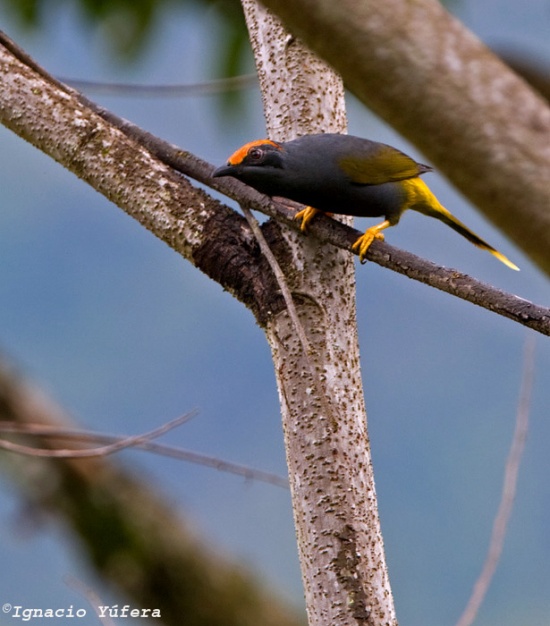Alternative names: Fiery-browed Starling; Flame-browed Starling; Celebes Myna
- Enodes erythrophris
Identification
27cm. A medium-sized starling with a long, strongly graduated tail and a distinctive coloured plumage.
- Bright orange-red band from nares backwards over and behind eye
- Black patch below and behind eye
- Dark charcoal-grey rest of head and upperparts
- Golden-yellow rump
- Olive-green to olive-brown wings
- Brown tail tinged with olive-yellow
- Charcoal-grey underparts except golden-yellow thighs and undertail-coverts
- Pale yellow or sepia eye
- Black bill
- Sulphur-yellow eye
Sexes similar. Juveniles are browner, the superciliary stripe is narrower and more yellow than orange-red.
Distribution
Endemic to Sulawesi, Indonesia.
A generally common and widespread restricted-range species.
Taxonomy
Regarded as monotypic by some authorities[1], others[2] recognize three subspecies:
- E. e. erythrophris in northern Sulawesi
- E. e. centralis in north-central and southeastern Sulawesi
- E. e. leptorhynchus in central Sulawesi
Habitat
Montane forest, also lowland and elfin moss forest. Sometimes at forest edge or in selectively logged areas.
Most numerous at 1000 - 1500m, but occurs up to 2300m.
Behaviour
Usually seen in pairs or trios, sometimes in bigger flocks.
Associates with Sulawesi Myna and Finch-billed Myna at fruiting trees.
Diet
Omnivorous, feeds on fruit and invertebrates.
Breeding
No information about breeding. Probably breeds in tree holes.
Movements
A resident species with some local movements.
References
- Clements, J. F., T. S. Schulenberg, M. J. Iliff, B.L. Sullivan, C. L. Wood, and D. Roberson. 2013. The eBird/Clements checklist of birds of the world: Version 6.8., with updates to August 2013. Downloaded from http://www.birds.cornell.edu/clementschecklist/download/
- Del Hoyo, J, A Elliott, and D Christie, eds. 2009. Handbook of the Birds of the World. Volume 14: Bush-shrikes to Old World Sparrows. Barcelona: Lynx Edicions. ISBN 978-8496553507
Recommended Citation
- BirdForum Opus contributors. (2024) Fiery-browed Myna. In: BirdForum, the forum for wild birds and birding. Retrieved 9 November 2024 from https://www.birdforum.net/opus/Fiery-browed_Myna




